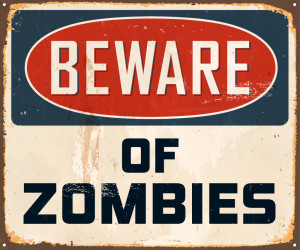In honor of the new writing year, I’m assembling a personal checklist of “Do’s and Don’ts” to follow. I’ll kick off my list with an issue that always makes me cranky as a reader: the sudden appearance of a “zombie” character.
What is a zombie character?
Zombies are characters that are initially introduced into a story, but then vanish for long stretches. By the time a zombie is abruptly resurrected by the writer (usually without any context or reminder), the reader has forgotten who the zombie character is. The sudden reappearance of a zombie can make a reader feel lost and confused (and probably irritated with the writer).
I encounter zombies frequently in my critique group. I’ll be reading a scene from someone’s draft, for example, and suddenly a minor-sounding character named Bill pops up to contribute a bit of dialogue. There’s no description to remind me who Bill is, nor anybody indication of where he’s been lurking all this time. When I ask the writer who “Bill” is, this is usually how the conversation goes.
Writer: Oh, don’t you remember Bill? I mentioned him six chapters ago. (Writer’s tone implies that her reader has a faulty memory).
Kathryn: No, I’ve long since forgotten your underwritten, generic, and ineptly re-introduced character named “Bill”.
(Okay, I don’t actually say that, because then I would sound cranky).
How to re-introduce a missing character
There are a couple of ways to reintroduce a character who has gone missing, like Bill.
1) If Bill has been “off-camera” briefly within a scene, you can re-focus the reader’s attention on him by using a single sentence. For example, let’s say you have a scene with three characters, and two of them have been having a heated argument. Now you need to re-introduce Bill, who hasn’t said anything so far. This is one way you might do it:
Bill, who’d been listening to us from his unsteady perch on the broken stool, cut in to deliver a verdict. “You’re both wrong,” he said.
2. If Bill has been missing in action for a longer period of time (for several scenes or chapters, for example), you can re-introduce him by reusing a specific attribute or detail that was important to his original characterization. If Bill had messy hair in his first appearance, for example, you can recall that characteristic when he reappears later (i.e., by showing him running his hand through his mane in a failed attempt to pull himself together).

Important: For this method to work, a writer must establish vivid, ‘reusable’ characteristics when a character is first introduced into the story. Those details will be reused later, in order to re-establish the character in the reader’s head.
Best Practice: Make your character details specific, vivid, and memorable. Discard trivial, generic details that won’t be reused later.
Question for you: How do you re-introduce MIA characters in your work? As a reader, have you ever had to go back a few pages to remind yourself who a character is?,


Kathryn, many of us include a character list with the manuscript we submit, telling the editor about the character (body habitus, where he/she lives, kind of car they drive, etc.), in order that they can catch inconsistencies (and be reminded of who the heck that is). Unfortunately, we sometimes forget that the reader has no such memory aid. This is one thing which my first reader and wife has taught me to recall. Thanks for the reminder.
Thanks Richard! I have found that by paring down character descriptions so that they include only important attributes that will be reused later, it becomes easier to avoid the creation of “stock” characters. I once wrote a story in which every character had blue eyes when they were first introduced. That made me realize that some self-editing and rewriting was in order.
Good point, Kathryn. I once had an editor remind me that not every woman was a blue-eyed blonde!
There’s nothing more annoying than reading a story where a character reappears that was never memorable to start with, forcing you (the reader) to flip back through the pages to try and find who it is and why you should care that they have ‘returned’ to the story. I think readers can easily be prompted to keep in mind a minor (but possible crucial) character by having other characters reference the MIA one – in dialogue or as an inner thought perhaps – especially if there’s a valid reason for their absence for long stretches. Otherwise, I figure if it’s a character no one remembers then bin ’em…
That’s another good way to reintroduce characters, Clare–by having other characters react, interact, and/or use the name in dialogue. But all too often, the reintroduction is simply a snippet of dialogue, followed by “Bill said.” It makes me nuts.
“Who are you, and what do you want?”
I call these my characters whoa-what characters. They may be necessary for some purpose, mundane or otherwise.I often give them despicable or disgusting habits, or pleasant, happy characteristics.
Bart walked away from Cheatam’s foul smell. Maybe Cheatam couldn’t help it, but he really was rancid.
Four chapters later, Cheatam reappears. “Four feet before Cheatam walked into the room, Bart knew the guy was around. Honest, the guy’s stench preceded him by four feet everywhere he went. But Bart knew: Cheatam was the only solution to getting rid of his problem.”
Or,
“Annette turned her head as she smiled. She was as nice as the light scent of perfume she apparently spritzed on every morning.”
Four years later, Annette appears out of nowhere. “Hi,” the woman said. “Do you remember me?”
Of course I did. I couldn’t forget her perfume. Or the Glock 9 she used to carried in her clutch. I hope she still packed heat. She was going to have to save my life. Again.
Great examples of injecting ‘vivid’ into your character descriptions, Jim! I love the idea of using scent, either good or foul, to establish presence. Beats blue eyes any day!
Funny you should mention this. Just the other day, one of my critique group buddies gave us a chapter where the bad guy shows up and we all did one of those Scooby Doo “HUHs?”
He had made one of the cardinal sins of crime fiction: not making the villain a credible presence early enough in the book for him to be believable when he finally does walk on stage. My critique bud tried to defend it, telling us the guy DOES appear earlier but he was so insubstantial that none of us remembered him. Maybe this is a variation of one of my favorite bad-writing characters: the long-lost zombie uncle from Australia.
I think much floundering by writers is due to the fact that we tend to “see” our characters and story clearly inside our own heads, so clearly that it almost becomes like watching a mental movie. It’s easy to overlook the areas in which our words on the page fail to “thought transfer” that same movie into the mind of a reader.
Pingback: About This Writing Stuff… | Phil Giunta – Paranormal, Fantasy, and SF Writer